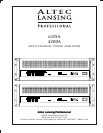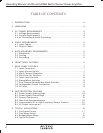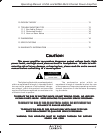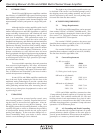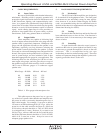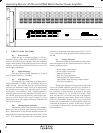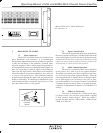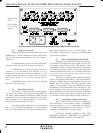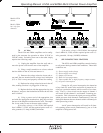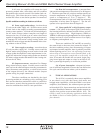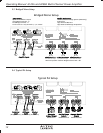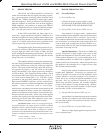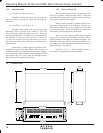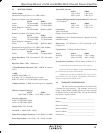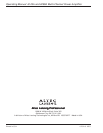
10
Operating Manual 6125A and 4200A Multi-Channel Power Amplifier
In all cases, the amplifier will restart the signal
processing module after a short delay and will reconnect
the speakers after several seconds if no further fault con-
ditions exist. This allows the servo circuitry to bring any
residual DC offsets to zero before speakers are connected.
Specific conditions resulting in a fault are as follows:
8.1 Power supply undervoltage - less than about
55 volts on the either supply rail. Possible causes would
be total load on the outputs exceeding recommendations
(remove some speakers - 4Ω load min, 8Ω min bridged),
low AC mains voltage (reduce extension cord length or
increase wire size, or switch to an AC mains circuit more
capable of supporting the amplifier's power requirements),
or improper AC inlet mains voltage setting (make sure
nominal AC mains voltage matches the number in the view-
ing window on the AC inlet).
8.2 Power supply overvoltage - more than about
92 volts on either supply rail. Possible causes would be
high AC mains voltage (change to an AC mains circuit with
voltage within the amplifier's stated requirements) or im-
proper AC inlet mains voltage setting (make sure nominal
AC mains voltage matches the number in the viewing win-
dow on the AC inlet).
8.3 Output overcurrent - more than 15 to 20 amps
being drawn from any output. Possible causes would be
total load on the affected output exceeding recommenda-
tions (disconnect some speakers), or a short circuit on one
of the outputs driven by the affected module (inspect
speaker wiring for proper connection).
The above conditions are checked by the signal
processing module on a switching cycle by switching cycle
basis and are therefore monitored as often as a million or
more times a second, allowing protection well before de-
structive conditions have time to cause part failure.
8.4 Heat sink overtemperature - a measured heat
sink extrusion temperature of more than 85 to 90 degrees
C. The three-speed fan will switch to medium speed at an
extrusion temperature of 45 to 50 degrees C, and to high
speed at a temperature of 70 to 75 degrees C. The
overtemperature fault will clear itself when the measured
temperature is below about 70 degrees C. The fan will
operate at low speed below about 50 degrees C.
8.5 Unacceptable DC or high frequency output
content - a DC offset in the output signal of more than a
few hundred millivolts indicates module failure, and will
trigger a DC protect fault. High frequency (20kHz to
100kHz) in the output at high amplitudes can cause speaker
damage and causes a fault condition more or less rapidly
as frequency and amplitude vary.
These two conditions (DC and HF) are tested by
the same circuit so the exact cause cannot be isolated. If
the fault condition persists after disconnecting all inputs
and outputs from the amplifier, there is probably a module
failure requiring service. Note: the self-testing circuit may
take as long as 30 seconds to recover from this fault, so be
sure to give the amplifier enough time to reset itself. If
after 30 seconds the module has recovered, begin plug-
ging in one input and output at a time in an effort to iso-
late a system high-frequency or oscillation problem.
8.6 AC power interruption - a dropout (or brown-
out of sufficient magnitude) of more than one half mains
line cycle and less than one whole cycle in duration.
9. TYPICAL APPLICATIONS
The 6125A is essentially three stereo amplifiers
in one chassis, each with dual stereo, dual mono, and
bridged mono capabilities, while the 4200A is two stereo
amplifiers (four channels), but with more power per chan-
nel than the 6125A. Input connections are hard-wired with
two-piece Euroblock connectors, while speaker outputs are
wired to four position screw terminal blocks. Note: The
6125A is used for the following application details, but
the 4200A is used in a similar fashion, to a maximum of
four channels.



